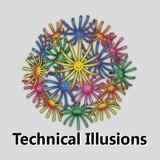If you have ever used a 3D printer before, then you know how boring it can be to wait in anticipation for your 3D model to print out. Often times I find myself just staring at my 3D printer, wondering, “when will this ever get  done, and when it’s done will it be the right size I want?” Well, thanks to a pretty clever guy named Ryan Smith, you no longer have to wait to get a good idea of what the finished print will look like.
done, and when it’s done will it be the right size I want?” Well, thanks to a pretty clever guy named Ryan Smith, you no longer have to wait to get a good idea of what the finished print will look like.
Ryan Smith, lead 3D artist at a company called Technical Illusions, has created a holographic augmented reality interface for previewing 3D prints in his Makerbot Replicator. Sounds pretty darn futuristic, huh? Well it is. To do this, Smith started with a Cast AR headset, which is the product of an extremely successful Kickstarter campaign back in November, when they raised over $1 million from 3,863 backers. From there he drilled holes into the retroflective material on the Makerbot, using a laser cutter. This allowed him to place a semi-transparent overlay on the front  window of his Makerbot Replicator, the area which most people rely on to watch their prints progress. When the glasses are placed on a user’s face, a holographic visualizer appears on the printer. The visualizer can display the finished object, other parts which will eventually go with that object, or whatever the user wishes.
window of his Makerbot Replicator, the area which most people rely on to watch their prints progress. When the glasses are placed on a user’s face, a holographic visualizer appears on the printer. The visualizer can display the finished object, other parts which will eventually go with that object, or whatever the user wishes.
“Once you put them on, you can actually visualize what you are going to print before you print it,” explained Smith. “With this application I am able to reach in and kind of wrap my hand around the holographic style image and scale it up or scale it down, and see how it fits with different people. This is just the first thing we have used this for.”
Smith believes that this is the next evolution in 3D printing, especially for artists and engineers who rely on scaling. Visualizing an object within the printer is much easier than visualizing it on a computer screen, in which the scale can be skewed due to the screen’s size and resolution. Future applications for this technology could really run wild if developers are able to improve its implementation.
What do you think? Will this be a functionality of future 3D printers? Would you use such technology if you had it available? Let us know what you think at the 3DPB.com forum thread for about this article. Check out the video of Ryan Smith, showing just how this cool interface functions.
(Source: Hackaday.com )
Subscribe to Our Email Newsletter
Stay up-to-date on all the latest news from the 3D printing industry and receive information and offers from third party vendors.
You May Also Like
Printing Money Episode 17: Recent 3D Printing Deals, with Alex Kingsbury
Printing Money is back with Episode 17! Our host, NewCap Partners‘ Danny Piper, is joined by Alex Kingsbury for this episode, so you can prepare yourself for smart coverage laced...
Insights from Cantor Fitzgerald on AM’s Q1 2024 Landscape
A recent survey by Cantor Fitzgerald sheds light on the persistent challenges within the additive manufacturing (AM) industry in the first quarter of 2024. Based on responses from 38 industry...
3D Printing Financials: Xometry’s Scaling up and Strong Start to 2024
Xometry (Nasdaq: XMTR) kicked off 2024 with strong results, boosting its marketplace and technology to new heights. Both revenue and gross margin soared, fueled by an expanding global network of...
3D Printing Financials: Desktop Metal Targets Recovery Amid Net Losses and Revenue Downturn
Despite facing a decline in revenue and the persistent challenges of a tight economic climate, Desktop Metal (NYSE: DM) is making strides toward operational efficiency. The first quarter of 2024...

































